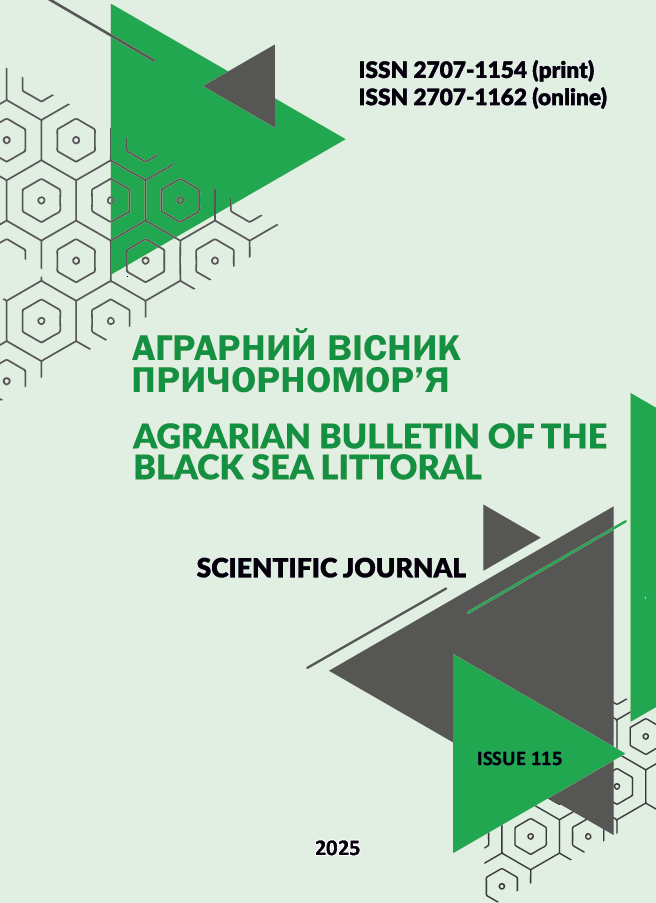CARCINOGENIC ACTIVITY OF A FEED ADDITIVE BASED ON HUMIC SUBSTANCES UPON REPEATED ORAL ADMINISTRATIO
DOI:
https://doi.org/10.37000/abbsl.2025.115.01Keywords:
humic acids, carcinogenicity, cytogenetic activity, laboratory rats.Abstract
Humic acids are polyanionic in nature and bind ions by various mechanisms, both chemical and physical. Compared to inorganic adsorbents (zeolites), their adsorption capacity is seven to ten times higher. Due to the heterogeneous nature of humic substances, the toxicological assessment of one specific substance was considered insufficient for extrapolation to the group as a whole, although efforts were made to identify an appropriate model substance. The aim of the research was to establish the carcinogenic effect for oral administration of sodium humate solution (feed additive "Гумівет") using a micronucleus test. For the preparation of the oral form, brown coal from the Cherkasy deposit (Ukraine) with the following characteristics was used as raw material: humidity - 24.36%, ash content - 24.1%, organic matter - 51.5%. The prediction of the carcinogenic effect of oral administration of the feed additive "Гумівет" was carried out using the micronucleus test (a method for assessing genotoxicity by detecting micronuclei in mammalian bone marrow cells). Male and female white nonlinear mice with a body weight of 24.0-27.0 g were taken as an experimental model. In the first series of the experiment, the feed additive "Гумівет" (solution for oral administration) in doses of 0.80 and 4.0 ml/kg of body weight was administered intragastrically via a probe once only to male mice (n=6) with fixation of the cellular material 24 h after administration. In the second series, the tested feed additive was similarly administered to male and female mice (n=6) daily for 5 days. The fixation of the cellular material was carried out 24 h after the last administration. To conduct an experiment based on the principle of analogues, two control groups (positive and negative control) of 6 mice each were also formed. With a single administration of the feed additive “Гумівет” at the rate of 0.8 ml per kg of live weight, no changes in cytogenetic activity were detected, as evidenced by the absence of a significant increase in polychromatophilic erythrocytes. The positive obtained result indicates that the substance induces chromosomal damage and / or disruption of the mitotic apparatus of cells in experimental animals. The proportion of polychromatophilic erythrocytes from all erythrocytes should not normally exceed 0.2%. Analysis of the cytogenetic effect of the feed additive “Гумівет” with oral administration for five days showed that in mice from the positive control group (that received cyclophosphamide at a dose of 20 mg/kg of body weight) the proportion of polychromatophilic erythrocytes was (0.667-0.683)%.
References
Stefanov, O. V. (2001). Doklinichni doslidzhennia likars'kykh zasobiv: metodychni rekomendatsii [Preclinical studies of medicinal products: methodological recommendations]. Kyiv: Avitsena. (In Ukrainian)
Aguilar, F., Charrondiere, U. R., Dusemund, B., Galtier, P., Gilbert, J., Gott, D. M., Grilli, S., Guertler, R., Kass, G.E.N., Koenig, J., Lambré, C., Larsen, J-C., Leblanc, J-C., Mortensen, A., Parent-Massin, D., Pratt, I., Rietjens, I.M.C.M., Stankovic, I., Tobback, P. … Woutersen, R. A. (2009). Chromium (III)-, iron (II)- and selenium-humic acid/fulvic acid chelate and supplemented humifulvate added for nutritional purposes to food supplements. EFSA Journal, 1147, 1-36.
Dai, C., Xiao, X., Yuan, Y., Sharma, G., & Tang, S. (2020). A comprehensive toxicological assessment of fulvic acid. Evidence-Based Complementary and Alternative Medicine: eCAM, 8899244. https://doi.org/10.1155/2020/8899244
European Medicines Agency. (2023). Maximum residue limits (MRL) for veterinary medicines. https://www.ema.europa.eu/en/veterinary-regulatory-overview/research-development-veterinary-medicines/maximum-residue-limits-mrl
Ferrara, G., Loffredo, E., Senesi, N., & Marcos, R. (2006). Humic acids reduce the genotoxicity of mitomycin C in the human lymphoblastoid cell line TK6. Mutation Research/Genetic Toxicology and Environmental Mutagenesis, 603(1), 27-32. https://doi.org/10.1016/j.mrgentox.2005.10.014
Murbach, T. S., Glavits, R., Endres, J. R., Clewell, A. E., Hirka, G., Vértesi, A., Béres, E., & Pasics Szakonyiné, I. (2020). A toxicological evaluation of a fulvic and humic acids preparation. Toxicology Reports, 7, 1242-1254. https://doi.org/10.1016/j.toxrep.2020.08.030
National Research Council (US) Committee on Risk Assessment of Hazardous Air Pollutants (1994). Science and judgment in risk assessment. Assessment of toxicity. Washington, DC: National Academies Press. https://www.ncbi.nlm.nih.gov/books/NBK208246/.
Ribas, G., Carbonell, E., Creus, A., Xamena, N., & Marcos, R. (1997). Genotoxicity of humic acid in cultured human lymphocytes and its interaction with the herbicides alachlor and maleic hydrazide. Environmental and Molecular Mutagenesis, 29(3), 272-276.
Sabi, R., Vrey, P., & Van Rensburg, C. (2012). Carbohydrate-derived fulvic acid (CHD-FA) inhibits carrageenan-induced inflammation and enhances wound healing: Efficacy and toxicity study in rats. Drug Development Research, 73. https://doi.org/10.1002/ddr.20445
Timothy, S. M,., Glávits, R., Endres, J., Clewell, A., Hirka, G., Vértesi, A., Béres, E., Szakonyiné, I. (2020). A toxicological evaluation of a fulvic and humic acids preparation. Toxicology Reports, 7, P. 1242-1254. https://doi.org/10.1016/j.toxrep.2020.08.030
Vasková, J., Stupak, M., Vidova Ugurbaş, M., Zatko, D., & Vasko, L. (2023). Therapeutic efficiency of humic acids in intoxications. Life, 13(4), 971. https://doi.org/10.3390/life13040971
Downloads
Published
How to Cite
Issue
Section
License

This work is licensed under a Creative Commons Attribution-NonCommercial 4.0 International License.


